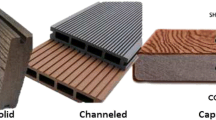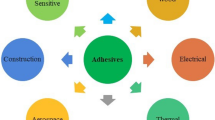Abstract
Improved water resistance of hardened UF resins for plywood was achieved by addition of up to 20% on UF resin solids of the hydrochloride salt of hydrolysed waste nylon fibre obtained from ladies stockings. The nylon salt is added in powder form directly to the glue mix of the UF resin for ease of handling, and also functions as the only hardener of the resin. The salt remains as a finely devided powder in suspension in the glue mix at ambient temperature ensuring a long pot-life. Its rapid dissolution as the temperature of the glue line increases during hot pressing also ensures rapid availability of both the acid functions for hardening and of the nylon short oligomers for reaction with the UF resin. The short length oligomers of nylon still present in the salt coreact during hot pressing with the UF resin forming in the majority an unitary hardened, solid network. The amidic groups present in the body of the chains of the short nylon oligomers are shown to react with the methylol groups of the UF resin and thus the nylon is bound in the hardened network by a series of methylene linkages between the majority of its secondary amide groups to the urea. The determining parameter as regards performance results is the set of conditions used to hydrolyse the nylon fibre and to prepare the salt. The waterproofing obtained approaches, but is lower than, that of melamine-urea-formaldehyde adhesives of low melamine content.
Zusammenfassung
Eine verbesserte Wasserwiderstandsfähigkeit von ausgehärteten UF-Harzen für Sperrholz konnte erreicht werden durch Zusatz von hydrolysierten Nylonabfällen aus Damenstrümpfen. Der Anteil der Hydrochlorid-Salze betrug bis zu 20% des Festharzgehaltes. Die Nylonsalze werden einfach als Pulver zur Harzmischung zugegeben und sind der einzige Härterzusatz in dieser Mischung. Die Salze bleiben als fein verteilte Suspension im Harz und sichern so eine lange Gebrauchsdauer bei Raumtemperatur. Mit steigender Temperatur lösen sich die Salze schnell auf und wirken während des Heißpressens einerseits als Härter. Andererseits reagieren diese kurzkettigen Oligomere als Co-Polymere mit dem UF-Harz und bilden dadurch ein einheitliches festes Netzwerk aus. Es konnte gezeigt werden, daß die Amidgruppen der Nylonoligomere mit den Methylol-Gruppen des UF-Hurzes reagieren, so daß die Nylonsalze über eine Vielzahl von Methylenbrücken zwischen den sekundären Amidgruppen und dem UF-Harz gebunden werden. Wesentlichen Einfluß auf die Qualität des ausgehärteten Harzes haben die Bedingungen der Hydrolyse und die Herstellung der Nylonsalze. Die Wasserfestigkeit ist etwas geringer als die von Melamin-UF-Harzen mit niedrigem Melamingehalt.
Similar content being viewed by others
References
Dixon, W. T., Spinning-side-band-free and spinning-side-band-only NMR spectra in spinning samples. J. Chem. Phys. 77: 1800–1803 (1982)
Ebewele, R. O.;Myers, G. E.;River, B. H.;Koutsky, J. A. Polyamine modified urea-formaldehyde resins I: Synthesis, structure and properties, J. Appl. Polymer Sci., 42: 2997–3004 (1991)
Ebewele, R. O.;River, B. H.;Myers, G. Behaviour of amine-modified urea-formaldehyde-bonded wood joints at low formal-dehyde/urea molar ratio, J. Appl. Polymer Sci., 52: 689–700 (1994)
Pizzi, A. On the correlation of some theoretical and experimental parameters in polycondensation cross-linked networks, J. Appl. Polymer Sci., in press (1996)
Pizzi, A.; Tekely, P. unpublished results, (1996)
Prestifilippo, M.;Pizzi, A.;Norback, H.;Lavisci, P. Low addition of melamine salts for improved UF adhesives water resistance, Holz Roh Werkstoff, 54: 393–398 (1966)
Wang, S.; Pizzi A. Succinaldehyde-induced water resistance improvements of UF wood adhesives, Holz Roh Werkstoff, in press (1996)
European Norm UNI EN 314, pretreatment 5.1.3, Plywood bonding quality (1993)
Author information
Authors and Affiliations
Rights and permissions
About this article
Cite this article
Wang, S., Pizzi, A. Waste nylon fibre hardeners for improved UF wood adhesives water resistance. Holz als Roh-und Werkstoff 55, 91–95 (1997). https://doi.org/10.1007/BF02990524
Issue Date:
DOI: https://doi.org/10.1007/BF02990524




